Spencer Hulsey, the Face of the Physics Van: Passionate About Physics—and Outreach

Spencer Hulsey calls on a young student who's volunteering to participate in a demo during a recent Physics Van show.
“I was born not knowing, and have had only a little time to change that here and there.” – Richard Feynman.
February 5, 2020
This is one of Physics senior Spencer Hulsey’s favorite quotes by physicist Richard Feynman, who helped to pique her interest in physics. However, someone who had an even more significant impact on her love of physics and decision to study it was her high school physics teacher, Steve Eischens. And while Hulsey loves physics research (she’s worked for four different professors), probably her favorite thing to do is outreach. In fact, all who have seen the co-coordinator of the Physics Department’s long-standing outreach group in action might aptly call her “the Face of the Physics Van.”
Physics Van is a group of mostly engineering and physics students (and even a few non-engineering students) who do fun, engaging, often spectacular demonstrations about science, particularly physics. Hulsey, who began as a Physics Van volunteer her freshman year, became one of the Van’s two coordinators at the end of her freshman year, and has been doing it ever since.
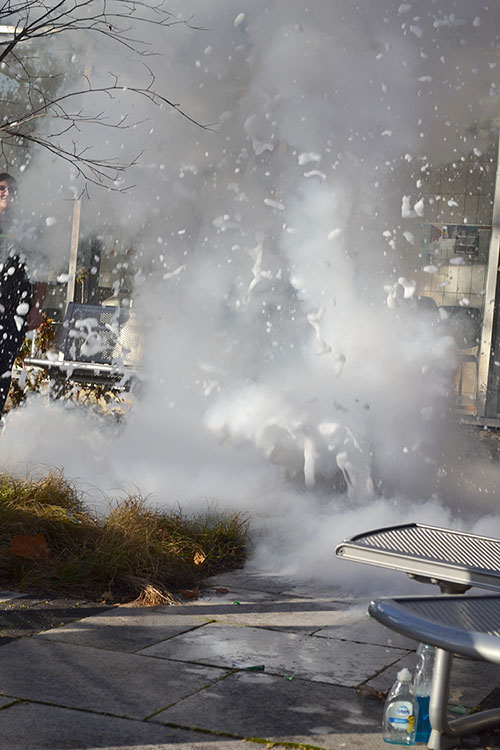
One of Spencer Hulsey's favorite demos: the soapsuds explosion.
What are Physics Van shows like? They involve demos interspersed with humorous banter bordering on slapstick comedy, which feature explosions, lots of noise, light shows, and that make liberal use of liquid nitrogen. In fact, many of the van’s demos involve liquid nitrogen: shooting the cork from a miniature cannon filled with liquid nitrogen, shattering a bouncy ball quick-frozen in liquid nitrogen, shrinking a balloon animal in the stuff, then watching it expand.
So what is Hulsey’s favorite Physics Van demonstration? “Oh, it has to be an explosion,” she admits. “I’m just like the kids—explosions all the way!” And, of course, they involve liquid nitrogen.
They usually have two explosions at the end of the show. One is a bubble explosion: liquid nitrogen is added to dish soap in a bucket, causing a geyser-like explosion of soapsuds. However, Hulsey’s personal favorite is the bottle explosion. A team member fills a soda bottle with some liquid nitrogen, seals it, then puts it in a trash can with the trash can lid on. As the gas inside the bottle expands, it causes the pressure inside the can to build. When the bottle explodes, it shoots the lid off, sometimes 40 feet into the air. “We once put the trash can lid on the roof!” she brags.
Some of the outreach’s venues include: schools, community events, such as at the liabrary, the Farmer’s Market in Urbana, even the cub scouts—one of Hulsey’s favorite events. “Those kids are always so nice and so energetic. And they help us. Every Cub Scout event I've been to, they've helped us unload and load the van. And they're always very responsive.”
Of all the Physics Van venues, Hulsey particularly appreciates presenting at the smaller schools, because they remind her of home. “I personally get excited whenever a small school requests us, because that's like my school. I had a graduating class of 38 kids.” About two hours south of here, her school, South Central High School, is in Farina, Illinois, whose population is “Like 300 on a good day…We have more chickens than we have people,” she admits.
In fact, Hulsey’s school didn't even have physics classes or AP courses. “Our school is way too small,” she says. But despite its lack of college-prep programs, here she is—majoring in physics at Illinois. She credits Steve Eischens, her physics high school teacher. “He was awesome. He taught me so much.” You may ask, "Why have a physics teacher if the school offered no physics courses?" The explanation follows.
To matriculate to Illinois, Hulsey needed specific science courses to fulfill entrance requirements. So since her school offered no Physics class, she took a Physics Independent Study which Hulsey calls exploratory and student led. It had a rather small class size—just her and her teacher. They met every day, just like a regular class, but because of the “class size,” were free to explore various physics experiments Eischens would find online for her to try out. She recalls her working relationship with the teacher: “He would jump in and be like, ‘How about this?’ And I'm like, ‘It's a great idea!”
So the course pedagogy was to research, do experiments, then write about her experience. She shares one caveat regarding the independent study: “Everything I did, he would want me to write a report…so it kept it real.” Regarding the course’s methodology, Hulsey quotes Adam Savage, former co-host of the Discovery Channel television series MythBusters and Unchained Reaction: “The difference between screwing around and science is writing it down.” So based on her independent study’s stringent reporting requirements, it was “science and not just goofing around,” she claims.

Spencer Hulsey tries to pull apart a pair of evacuated Magdeburg hemispheres: the air has been sucked out, causing a vacuum.
Once, Hulsey actually built a Trebuchet (traditionally done in physics classes). “The local lumberyard just donated wood, and I built a Trebuchet, and then we played around with that, and the physics with it, and then we launched it.” Once, Eischens suggested, “‘Why don't you figure out how to capture CO2 production?’ So I tried that.” She also tried making bio fuel out of coffee, which was big at the time.
Another project was reading all of Richard Feynman works, both his biographies and his lectures. She says Feynman is “pretty much known as the best science communicator," adding, “But I loved it. I can't deny the impact he had on my early physics ‘career.’” Regarding Feyman, she adds: “He was hilarious. He inspired people, and he just liked to do incredible things.” Hulsey claims he inspired her love of science outreach. “Absolutely. He's pretty famous. He's known for bringing science to the public, and I love that. That's what I like to do. So he and I ‘vibed.’”
Along with the quote at the beginning of the article, another of her favorites is: “You have no responsibility to live up to what other people think you ought to accomplish. I have no responsibility to be like they expect me to be. It's their mistake, not my failing.”
At the end of the year in her independent study, she did a research project on photons. “That's why I like it a lot now,” she concedes, referring to photons, “because I got to pick the subject myself.”

Spencer Hulsey interacts with a group of students visiting campus from Chicago.
Hulsey obviously loves physics and science right now, but did she love it as a kid? “Yep. Biology!” she claims. “Biology was always where I fit the best, actually.” Stressing that she really loved biology, still loves it, and will love it forever, she adds: “But then I realized, ‘I don't want to do this!’”
Although she says, “Biology was just so easy. It always just came so naturally,” at that time, she and her biology teacher were at odds with regards to what she wanted to do with biology and what her school offered, while her physics teacher told her, “’Just do whatever you want!’ Hulsey believes her inability to go the direction she wanted played a big part in her choosing physics over biology: “So I think I got more enthusiasm for physics than I ever did for biology.”
How’d Hulsey end up at Illinois? She credits Physics’ teaching guru, Mats Selen…and Physics Van. She shares an anecdote.
As a junior, she had decided to major in physics, but hadn’t decided where she wanted to go; Illinois was just one of the schools she was considering. At that time, her school competed in state-level WYSE testing hosted by Illinois. She was the only kid from her school who had placed high enough, so she visited campus with a teacher to test in both physics and biology. Then, once testing was over, because she could do whatever she wanted, she sat in on Matt Selen’s lecture. “Wow!” she recalls. “He did the lecture!” (The lecture was the one her hero, Richard Feynman, was most famous for, which pretty much clinched her choice of Illinois.)
“Oh, I recognize this!” she exclaimed, regarding the Feynman bowling ball demo that illustrates Conservation of Energy. A bowling ball suspended from the ceiling is brought right next to an object (in the above video, it’s a guy’s face), then released; it swings forward then comes back but doesn’t touch the object it was next to. “And so I’m like, ‘That's so cool!’” She recalls: “I was just so excited! Like that was such a cool lecture that he did. It was full of these little fun demos. He had this hoop that he was spinning…” So afterwards she went up and told Selen, “Like, that was so neat!” and high fived him.
 Physics Van Co-Coordinator Spencer Hulsey.
Physics Van Co-Coordinator Spencer Hulsey.Not knowing who he was, once she discovered his name, she looked him up and saw that he did Physics Van. Plus, in an email from Physics citing things one could do in the department, Mats’ “Congratulations-and-welcome-to-the-department” spiel at the end had described the Physics Van opportunity. She instantly decided, “All right, I’ve just got to go there!”
Fast forward a year or two: after arriving on campus as a freshman, she went to see Mats Selen. “Mats,” she told him, “I don't know if you remember me, but I high-fived you at the end of a lecture.’” His response was, “’Absolutely, Spencer. I remember you wearing a pink dress and everything.” When she asked him about Physics Van, he told her, “‘Yeah, it’s this outreach group.’ I'm like, ‘That's what I want to do.’ And that's how I got started…This is how I got started in Physics Van,” she recalls (and how she ended up at Illinois).
(Spencer and Selen appear to be part of a mutual admiration society. Of the vibrant senior, he says: “Spencer is the most interesting and unique student that I have met in my 27 years at Illinois. Not only does she approach everything she does with amazing insight and innovation, but her interests and talents are extremely diverse. In a single conversation she is likely to explain a great new idea she came up with for computational processing of student feedback in Physics 211; showcase her proposal for a new mascot for the University of Illinois (complete with a beautiful Kingfisher painting that she made herself); and end by describing her two favorite ways of hypnotizing a chicken.”)
While Hulsey loves outreach, she wants to make sure kids are benefitting. Seconding my “So why expose kids to physics?” query, Hulsey agrees: “That is my question; I want to know what we're doing.” Anxious to discover the benefits of their program, she’s developing a research plan to assess how science exposure through Physics Van helps children. Until then, she shares what she perceives to be the rewards, challenges, and benefits of the outreach. “For one, it's fun for me,” she explains. “I love it.” She also enjoys the end of each outreach, when: “We get to ask these kids all these questions, and they ask us questions, and we can answer them.”
An interesting challenge is meeting people who don’t share her passion for science. “I actually got to meet a flat earther—a real flat earther!” she exclaims. “It was after a show once and she was asking me, ‘How do you know the world is round and not flat?’ And we talked about it. I'm like, ‘Wow!’” then adds, “But you get to meet people that otherwise would have so little connection to physics, and their kids, who get science from their parents.”
Hulsey stresses that one of Physics Van’s goals is to be a resource for schools. “When it comes to science, we get to just be a little bit more. We get to show them things that some schools don't have funding for…We can inspire kids in ways that not all schools can.”
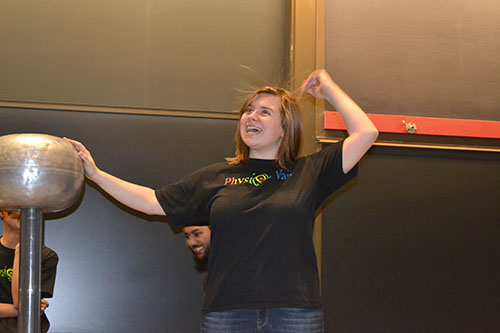
Spencer Hulsey demonstrates how the Van de Graaff Generator can cause one's hair to stand on end.
Regarding their main goal, Hulsey still isn’t sure. “I don't know if our goal is to just show them science, or to inspire them to be scientists, or to teach them. We teach things; it’s like our goal is to teach kids all these cool things. I don't know if it sticks or not, but you hope.”
Asked about her biggest hope, Hulsey says, “Oh man, that’s a hard question. Let me think about it.” After thinking about it for 30 seconds, she jumps up on her soap box, stating that her ultimate goal is science literacy for all.
“I know that not everyone's going to go into science, but I would really like to see an improvement in science literacy. I want people that keep leaving [school], that aren't going to go into science to realize that science is fun to know, right? Otherwise, whenever they leave school, they're going to stop learning. They're gonna stop exposing themselves to science. It’s like, ‘Oh, that was boring! I don't even care!’ And then we end up where we are now, where nobody cares about the science that's happening. And then Bill Nye lights the globe on fire (Nye had a highly publicized meltdown regarding most adults’ lack of concern about global warming), or we end up with people that believe the earth is flat, or that believe that vaccines are bad” (this writer’s own particular soap box).
Though Hulsey feels science literacy could improve, especially among adults, that’s not her mission. “I am not that person…I have access to kids, and so we should teach kids how cool science is, and maybe that'll carry on.”
While Hulsey finds connecting to people and being helpful personally rewarding, she’s also gained a great deal personally from her Physics Van experience. “The thing that I’ve gained the most is public speaking skills. I've always loved public speaking, but you can never have too much practice. And I've gotten so comfortable doing Physics Van. For a while I started out a little nervous…and now I can do all the demos. I feel comfortable teaching science concepts, and I think that's improved.” She also claims her interactions with kids in non-science conversations have improved. “I've learned how to work with them now,” she says.
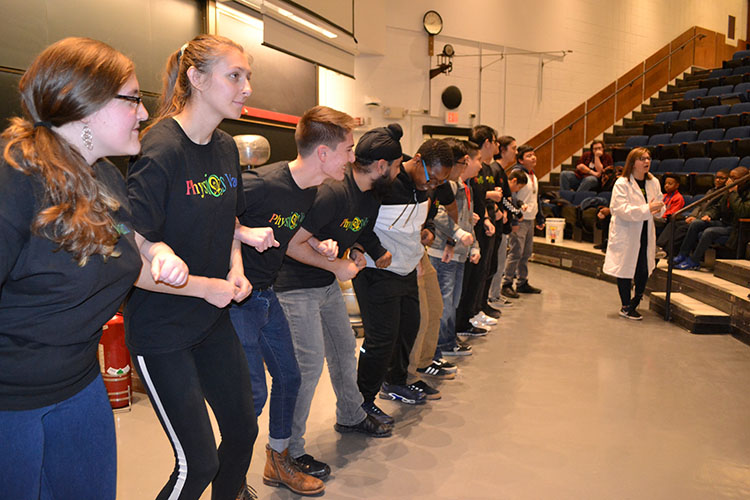
Spencer Hulsey (right) directs a demonstration where young Chicago students and Illinois Physics Van volunteers act out a gas heating up and expanding.
Currently majoring in physics specialized, “Physics plus physics,” she calls it. “Physics and then more intense physics,” Hulsey is also minoring in astronomy. Once she graduates, what are her career plans? When asked about her dream job, she quips, “Uh, does it have to exist now?” intimating that she wants a job that’s “tailor-made” to suit her skills and interests. For example, she might want to do outreach for a museum, but she’s also thought about teaching, although she’d prefer that it be more informal. “I would love to be like a traveling spokesperson, like Bill Nye, but more people, less TV. I love talking in front of people, public speaking.” She adds, “I love teaching kids science; they’re responsive to anything!” And it’s this love of teaching kids science that has driven her involvement with the Physics Van.
Regarding her favorite age groups, she says anything but high schoolers, which she calls, “scary!…But younger and older is fun.” In fact, she says college kids pretty much have the same reactions as elementary kids. When doing science demos for college kids during Quad Day, their response was: “’This is crazy! This is so cool,’—the same exact response as younger kids.
“The only difference between elementary kids and college kids is that college kids are afraid to ask questions,” she adds. "And that's really the biggest difference, because they think they should know it, and they don't want to ask.”
What has Physics Van meant to Hulsey personally? “It's been a great way to meet other physics people,” she says. In fact, she’s done research for four different physics professors, all of whom she met via—what else?—Physics Van. In fact, she advises fellow students to join in on the fun, suggesting that the outreach is a great way to connect with others who are passionate about physics. “That's how I got connected with other people that shared similar interests, so they could recommend me to the right person where I could be competitive.”
Along with the networking, Hulsey discloses another big reason she enjoys Physics Van: “I love access to liquid nitrogen, and I can get liquid nitrogen or whatever I want, and I love it!”
Story and photographs by Elizabeth Innes, Communications Specialist, I-STEM Education Initiative.
More: K-6 Outreach, Physics, Student Spotlight, 2020
For more on the Physics Van, see the I-STEM articles:
- 2020: Physics Van Uses Exciting Demos to Pique Students’ Interest in Science
- 2013: Physics Van: A Whole Lot of Fun… Plus, You Get to Blow Stuff Up
- 2013: Mats Selen–Changing the Way Physics is Taught.
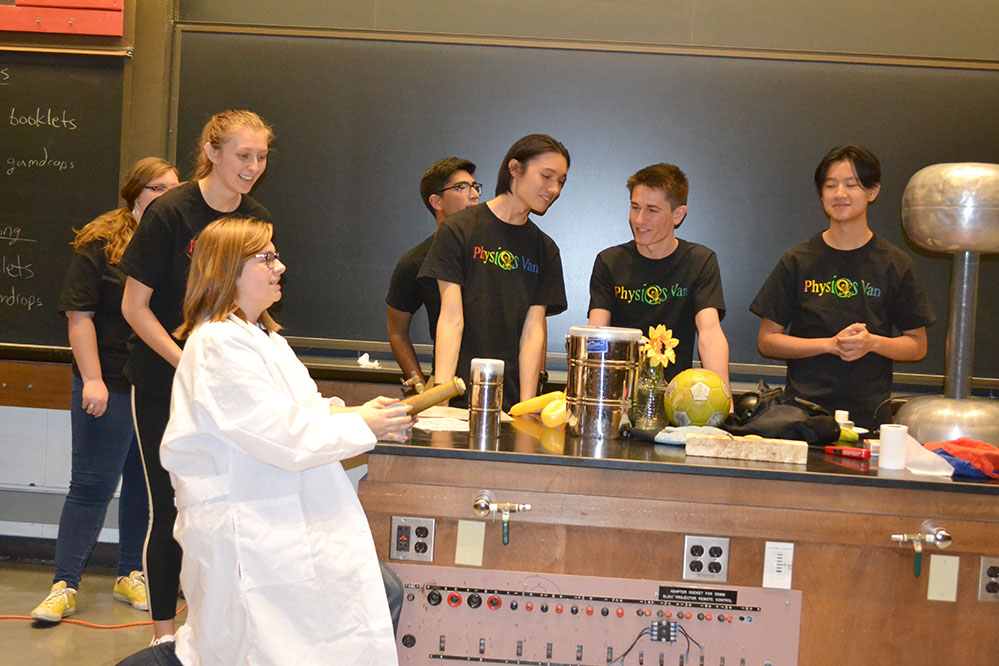
Spencer Hulsey does a demo where a cork is shot from a cannon using liquid nitrogen.
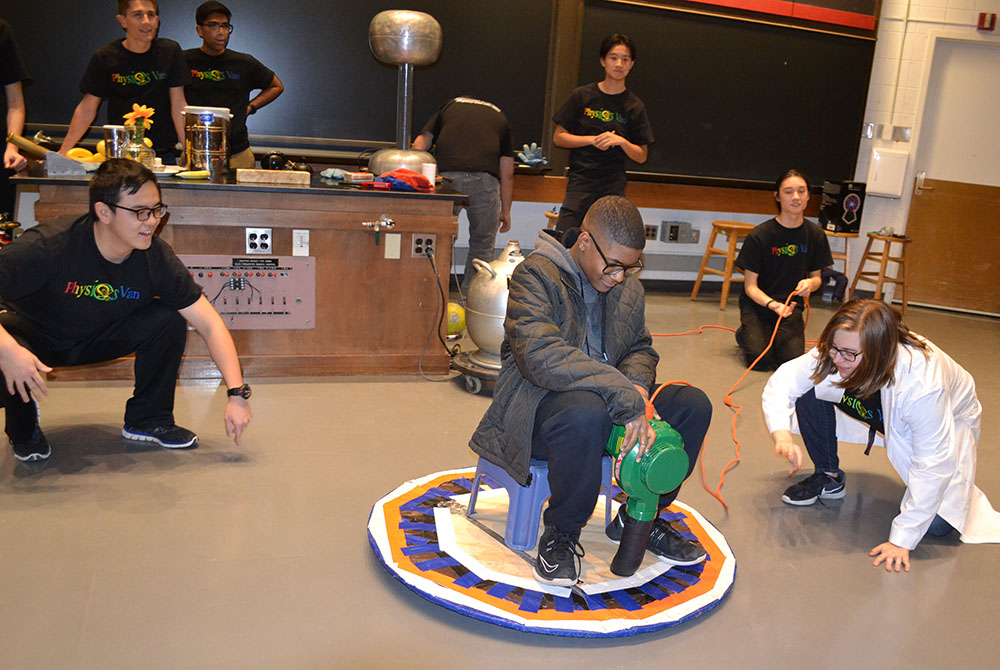
Spencer Hulsey (right) waits to give a shove to a student who's stool is a precursor to a hover craft; it's able to move across the floor, gliding on a cushion of air.













.jpg)
















